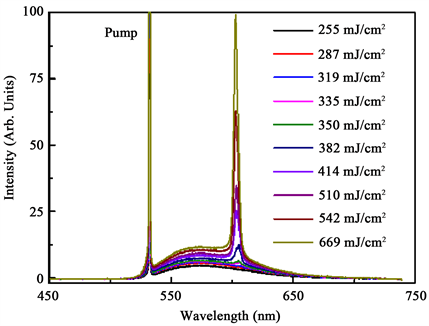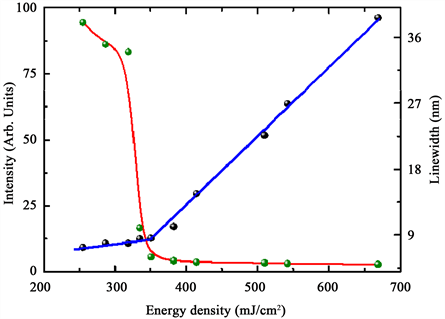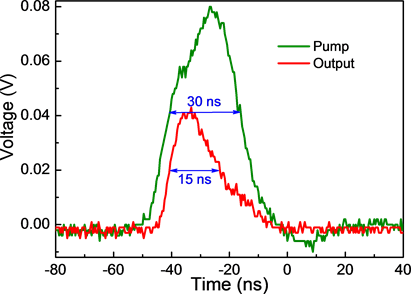Modern Physics
Vol.07 No.05(2017), Article ID:22143,7
pages
10.12677/MP.2017.75024
A Random Fiber Laser of Dye
Zhi Ren, Jinjian Song, Kun Ge, Ning Zheng
Department of Mathematics and Physics, North China Electric Power University, Baoding Hebei

Received: Sep. 2nd, 2017; accepted: Sep. 17th, 2017; published: Sep. 25th, 2017

ABSTRACT
In this paper, a fiber-type random laser was prepared after the volatilization process of the chloroform solution, combining PMMA with rhodamine 6G, which was siphoned into the capillary with the inner diameter of 0.5 mm. In addition, this paper also researched the random laser which is emitted from the fiber-type random laser, inspired by the pump light of 532 nm. The result shows that the center wavelength is 603 nm, threshold is 350 mJ/cm2, full width at half maximum (FWHM) is 4.5 nm and the pulse width is 15 ns involving in the random laser. A simple method for preparing a fiber-type random laser is presented and the basic parameters of the random laser are measured.
Keywords:Rhodamine
一种光纤染料随机激光器
任芝,宋金建,葛坤,郑宁
华北电力大学数理学院,河北 保定
收稿日期:2017年9月2日;录用日期:2017年9月17日;发布日期:2017年9月25日

摘 要
本文将PMMA和罗丹明6G的氯仿溶液虹吸到0.5 mm内径的毛细管内,待溶剂挥发后,制备成一种光纤型随机激光器,研究了光纤型随机激光器在532 nm的泵浦光作用下发射出的随机激光,中心波长位于603 nm、阈值为350 mJ/cm2,半峰全宽为4.5 nm,及脉冲宽度为15 ns。本文提出了制备一种光纤型随机激光器的简易方法,并测量了该随机激光器的基本特性。
关键词 :罗丹明

Copyright © 2017 by authors and Hans Publishers Inc.
This work is licensed under the Creative Commons Attribution International License (CC BY).
http://creativecommons.org/licenses/by/4.0/


1. 引言
自1968年,Letokhov做了关于随机激光器的相关报道,随机激光器开始引起人们的广泛关注 [1] 。不同于传统激光器,随机激光器并没有由全反射镜片等组成的光学谐振腔,而是通过使光子在无序增益介质中形成闭合回路,从而形成多重散射的方法,得到光放大的效果 [2] [3] [4] [5] 。当处于多重散射中的散射光子的增益强于损耗时,随机激光就会产生。因此,随机激光是散射和放大共同作用的结果。随机激光器由于空间相干性较低,其相应的光激发过程不同于传统激光器,在纳米技术、全视场成像、生物医药诊断、光子设备 [6] [7] [8] [9] [10] 等领域有潜在应用价值。目前,已有大量的材料可以产生光放大效果,如:半导体粉末、生物材料、染料液晶、聚合物 [4] [11] [12] [13] [14] [15] 等等。除选取的材料不同外,选取不同的基底也可以产生不同效果的随机激光,例如:波长可调谐随机激光器 [16] [17] [18] 、随机光纤激光器 [19] [20] [21] [22] [23] 、光流控随机激光器 [24] 、红绿蓝三色随机激光器 [25] [26] [27] 等等。
本文采用虹吸方法,制作了一种光纤随机激光器,具有制备方法简单,阈值低的优点,本文对输出随机激光的脉冲宽度进行测量,为随机激光的应用提供了更多参数。
2. 实验制备
选取聚甲基丙烯酸甲酯(PMMA)和有机染料罗丹明6G (R
将内径为0.5 mm的毛细管,一端浸入混合溶液,由于毛细管的虹吸效应,样品溶液会自动吸入毛细管中,置于干燥通风处,待有机溶剂挥发后,即可得到实验样品。
3. 结果分析
将制得的实验样品置于Leica DM300 LED光学显微镜下观测,得到如图1所示图像,其中图1(a)为未干燥处理过的样品图像,由于液体表面张力的原因,虹吸入毛细管内的溶液液面凹陷,呈现弧面,弧面左侧棕黄色部分为液态样品,弧面右侧灰色部分为未吸入液态样品的0.5 mm的毛细管在Leica DM300 LED光学显微镜下的图像。图1(b)为经过干燥处理后的样品图像,经干燥处理后,该弧面并未消失。并且弧面左侧样品经干燥处理后颜色加深,弧面右侧为氯仿溶剂挥发后残留在0.5 mm毛细管内壁的溶质。图1(c)为样品的结构示意图。混合溶液经过超声振荡后,PMMA和R6G分子均匀分布在溶液中,被虹吸入毛细管中,待有机溶剂挥发后,R6G分子均匀分散在PMMA圆柱内。
干燥后的样品置于待测实验台上。实验台装置如图2所示,泵浦源为Nd: YAG激光器,输出波长532 nm,脉冲宽度30 ns,重复频率10 Hz,单脉冲能量10 mJ。泵浦光经过衰减片到达分束器后分为两束光,使用功率计对其中一束泵浦光进行测量;另一束光经过凸透镜进行汇聚,在透镜焦点后方放置一块有

Figure 1. The microscope images of undried sample (a); dried sample (b); and the Schematic diagram of the structure of sample (c). The scale is 200 μm
图1. (a) 光学显微镜下未干燥处理过的样品图像;(b)光学显微镜下干燥处理后的样品图像;(c)样品结构示意图。标尺代表200 μm

Figure 2. Schematic diagram of the experimental measurement
图2. 实验测试示意图
小孔的黑纸片,用于消除多余泵浦光的影响。使光束透过小孔后到达毛细管内,激发样品,产生随机激光。出射的随机激光被Maya 2000 PRO光谱仪光纤探头接收,光纤探头与毛细管水平位置夹角为30˚,此时可以观测到出射的随机激光,记录得到的随机激光出射光谱。
在该随机激光器的增益介质中,染料R
为了进一步探究随机激光特性,图4(a)给出了出射随机激光强度随泵浦能量的变化关系,图4(b)为半峰全宽、出射随机激光强度与泵浦能量密度之间的关系曲线。出射随机激光的出射强度随泵浦能量增大而增大。当泵浦能量低于阈值(350 mJ/cm2)时,样品的发射光谱为自发辐射放大(ASE)。当泵浦能量增加至350 mJ/cm2时,出射光在原有ASE位置(603 nm)处,出现一条窄而细的尖峰,此尖峰即为随机激光。此时,出射随机激光强度较低。随着泵浦能量密度的不断增加,随机激光强度不断增加。如图4(b)所示,在阈值前后,出射随机激光的半峰全宽迅速降至4.5 nm;出射随机激光强度统计值,斜率发生明显变化,表明随机激光的产生。
为了进一步得到随机激光器的脉冲宽度参数,本文选用的实验仪器为光电倍增管(ETEnterprises QL3019/RFI)和数字示波器(Tektronix DPO4054)。实验装置如图5所示,光电倍增管采用高压电源供电,将采集到的光信号转化为电信号,并将电信号放大,之后传输给数字示波器。数字示波器将接收的电信号记录下来。图6所示为泵浦光脉冲、出射随机激光的时间特性图。YAG激光器输出532 nm的泵浦光,

Figure 3. Schematic diagram of the emission of the random laser
图3. 随机激光出射原理图
 (a)
(a) (b)
(b)
Figure 4. (a) Schematic diagram between the intensity of the emission of the random laser and the energy density of pump; (b) Schematic diagram between the intensity of the emission and the full width at half maximum (FWHM) of the random laser
图4. (a)出射随机激光强度与泵浦能量密度之间关系示意图;(b)出射随机激光强度、半峰全宽与泵浦能量密度之间关系示意图

Figure 5. Schematic diagram of the measuring device of the random laser pulse width
图5. 随机激光器的脉宽测量装置示意图

Figure 6. Schematic diagram of the time characteristics between the pump and the random laser in green and red, respectively
图6. 泵浦光(绿色)、随机激光(红色)的时间特性示意图
泵浦光光子在无序增益介质中形成闭合回路,从而形成多重散射,产生光放大效果,进而形成随机激光。一般而言,随机激光的脉冲宽度,与增益介质的荧光寿命的影响,即与R6G分子跃迁时间有关。本文,经多次测量结果,出射随机激光的脉冲宽度约为15 ns,泵浦光YAG激光器输出532 nm的脉冲宽度为30 ns。
4. 结论
本文通过将PMMA与R
基金项目
国家自然科学基金(No. 11004055),中央高校基本科研业务费专项资金(2016YQ11, 2016MS134, 2017MS198)和新世纪优秀人才支持计划(NCET-12-0844)。
文章引用
任 芝,宋金建,葛 坤,郑 宁. 一种光纤染料随机激光器
A Random Fiber Laser of Dye[J]. 现代物理, 2017, 07(05): 213-219. http://dx.doi.org/10.12677/MP.2017.75024
参考文献 (References)
- 1. Letokhov, V.S. (1968) Generation of Light by a Scattering Medium with Negative Resonance Absorption. Soviet Journal of Experimental & Theoretical Physics, 26, 835-840.
- 2. Lawandy, N.M., Balachandran, R.M., Gomes, A.S.L., et al. (1994) Laser Action in Strongly Scattering Media. Nature, 368, 436-438. https://doi.org/10.1038/368436a0
- 3. Asatryan, A.A., Stone, A.D., Vanneste, C., et al. (2010) Modes of Random Lasers. Physics, 3, 88-127.
- 4. Cao, H., Zhao, Y.G., Ho, S.T., et al. (1999) Random Laser Action in Semiconductor Powder. Physical Review Letters, 82, 2278-2281. https://doi.org/10.1103/PhysRevLett.82.2278
- 5. Horng, C.T., Ma, C.L., Lee, C.R., et al. (2015) Electrically and Thermally Controllable Nanoparticle Random Laser in a Well-Aligned Dye Doped Liquid Crystal Cell. Optical Materials Express, 5, 1469-1481. https://doi.org/10.1364/OME.5.001469
- 6. Cao, H., Redding, B. and Choma, M.A. (2014) Physics and Applications of Random Lasers. European Conference on Optical Communication, 1-2. https://doi.org/10.1109/ECOC.2014.6964242
- 7. Redding, B., Choma, M.A. and Cao, H. (2012) Speckle-Free Laser Imaging Using Random Laser Illumination. Nature Photonics, 6, 355-359. https://doi.org/10.1038/nphoton.2012.90
- 8. Polson, R.C. and Vardeny, Z.V. (2004) Random Lasing in Human Tissues. Applied Physics Letters, 85, 1289-1291. https://doi.org/10.1063/1.1782259
- 9. Yurlov, V., Lapchuk, A., Yun, S., et al. (2008) Speckle Suppression in Scanning Laser Display. Applied Optics, 47, 179-187. https://doi.org/10.1364/AO.47.000179
- 10. Wang, C. and Deng, L.G. (2014) Electrically Controlled Plasmonic Lasing Resonances with Silver Nanoparticles Embedded in Amplifying Nematic Liquid Crystals. Laser Physics Letters, 11, Article ID: 115814. https://doi.org/10.1088/1612-2011/11/11/115814
- 11. Molen, K.L.V.D., Tjerkstra, R.W., Mosk, A.P., et al. (2007) Spatial Extent of Random Laser Modes. Physical Review Letters, 98, Article ID: 143901. https://doi.org/10.1103/PhysRevLett.98.143901
- 12. Ye, L.H., Liu, B., Li, F.J., et al. (2016) The Influence of Ag Nanoparticles on Random Laser from Dye-Doped Nematic Liquid Crystals. Laser Physics Letters, 13, Article ID: 105001. https://doi.org/10.1088/1612-2011/13/10/105001
- 13. Huang, D.F., Xu, M., Liu, X.Y., et al. (2016) Low Threshold Random Lasing Actions in Natural Biological Membranes. Laser Physics Letters, 13, Article ID: 065603. https://doi.org/10.1088/1612-2011/13/6/065603
- 14. Liu, Y.J., Sun, X.W., Elim, H.I., et al. (2006) Gain Narrowing and Random Lasing from Dye-Doped Polymer Dispersed Liquid Crystals with Nano-Scale Liquid Crystal Droplets. Applied Physics Letters, 89, 3373.
- 15. Shang, Z., Tao, Z. and Deng, L. (2017) Random Lasing Assisted by CuSO4 and Au Nanoparticles in Random Gain Systems. Optical Materials Express, 27, 1848-1857. https://doi.org/10.1364/OME.7.001848
- 16. Wiersma, D.S. and Cavalieri, S. (2001) Light Emission: A Temperature-Tunable Random Laser. Nature, 414, 708-709. https://doi.org/10.1038/414708a
- 17. Eldardiry, R.G.S. and Lagendijk, A. (2011) Tuning Random Lasers by Engineered Absorption. Applied Physics Letters, 98, 1819.
- 18. Zhai, T.R., Chen, J., Chen, L., et al. (2015) A Plasmonic Random Laser Tunable through Stretching Silver Nanowires Embedded in a Flexible Substrate. Nanoscale, 7, 2235-2240. https://doi.org/10.1039/C4NR06632D
- 19. Li, S.T., Wang, L., Zhai, T.R., et al. (2015) Plasmonic Random Laser on the Fiber Facet. Optics Express, 23, 23985-23991. https://doi.org/10.1364/OE.23.023985
- 20. Turitsyn, S.K., Babin, S.A., Churkin, D.V., et al. (2014) Random Distributed Feedback Fibre Laser. Optics Express, 542, 133-193.
- 21. De Matos, C.J.S., De, S.M.L., Britosilva, A.M., et al. (2007) Random Fiber Laser. Physical Review Letters, 99, Article ID: 153903. https://doi.org/10.1103/PhysRevLett.99.153903
- 22. Babin, S.A., El-Taher, A.E., Harper, P., et al. (2011) Tunable Random Fiber Laser. Physical Review A, 84, 4903-4911. https://doi.org/10.1103/PhysRevA.84.021805
- 23. Hu, Z., Zhang, Q., Miao, B., et al. (2012) Coherent Random Fiber Laser Based on Nanoparticles Scattering in the Extremely Weakly Scattering Regime. Physical Review Letters, 109, Article ID: 253901. https://doi.org/10.1103/PhysRevLett.109.253901
- 24. Shivakiran Bhaktha, B.N., Bachelard, N., Noblin, X., et al. (2012) Optofluidic Random Laser. Applied Physics Letters, 101, 151101-151114. https://doi.org/10.1063/1.4757872
- 25. Chen, S., Zhao, X., Wang, Y., et al. (2012) White Light Emission with Red-Green-Blue Lasing Action in a Disordered System of Nanoparticles. Applied Physics Letters, 101, Article ID: 091101. https://doi.org/10.1063/1.4754286
- 26. Shi, X., Wang, Y., Wang, Z., et al. (2014) Random Lasing with a High Quality Factor over the Whole Visible Range Based on Cascade Energy Transfer. Advanced Optical Materials, 2, 88-93. https://doi.org/10.1002/adom.201300299
- 27. Li, S., Zhai, T., Zhang, X., et al. (2017) Red-Green-Blue Plasmonic Random Laser. Optics Express, 25, 2100-2106. https://doi.org/10.1364/OE.25.002100